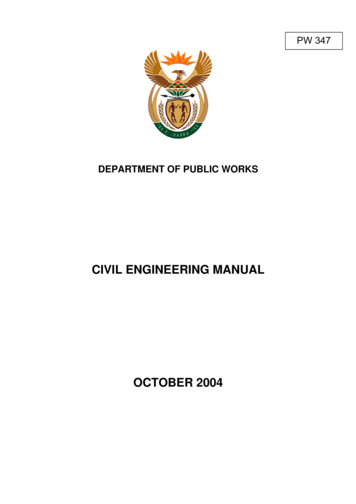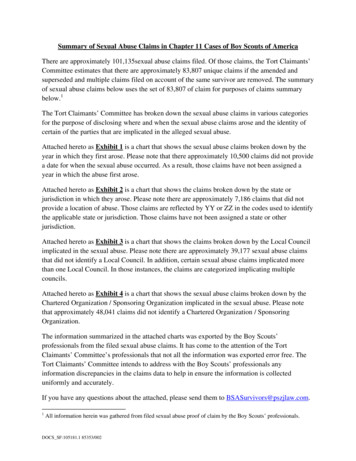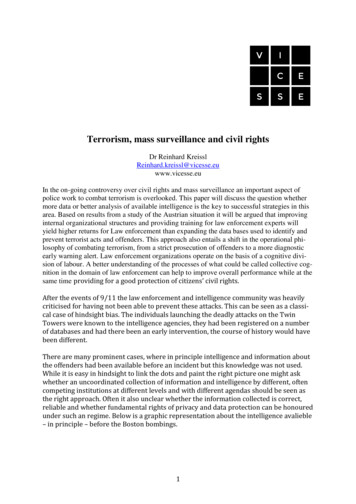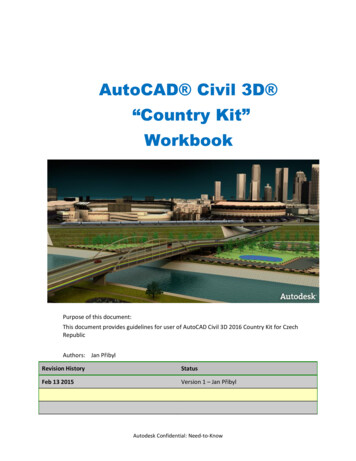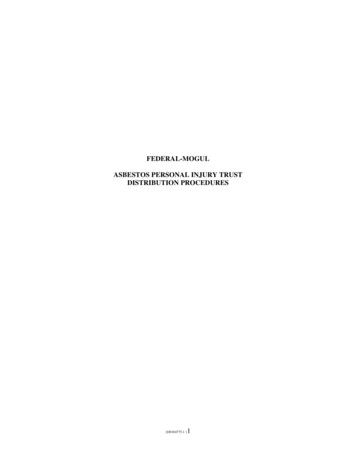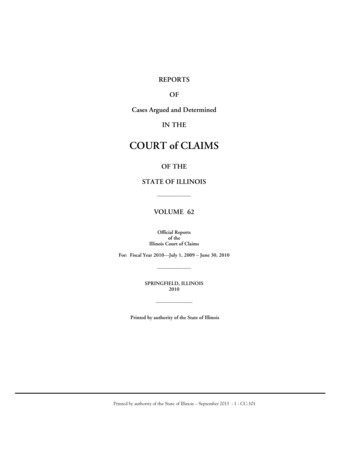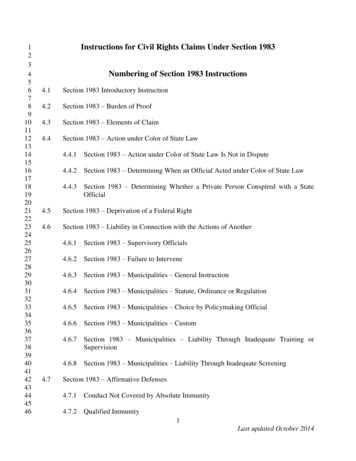
Transcription
031323334353637383940414243444546Instructions for Civil Rights Claims Under Section 1983Numbering of Section 1983 Instructions4.1Section 1983 Introductory Instruction4.2Section 1983 – Burden of Proof4.3Section 1983 – Elements of Claim4.4Section 1983 – Action under Color of State Law4.4.1Section 1983 – Action under Color of State Law Is Not in Dispute4.4.2Section 1983 – Determining When an Official Acted under Color of State Law4.4.3Section 1983 – Determining Whether a Private Person Conspired with a StateOfficial4.5Section 1983 – Deprivation of a Federal Right4.6Section 1983 – Liability in Connection with the Actions of Another4.74.6.1Section 1983 – Supervisory Officials4.6.2Section 1983 – Failure to Intervene4.6.3Section 1983 – Municipalities – General Instruction4.6.4Section 1983 – Municipalities – Statute, Ordinance or Regulation4.6.5Section 1983 – Municipalities – Choice by Policymaking Official4.6.6Section 1983 – Municipalities – Custom4.6.7Section 1983 – Municipalities – Liability Through Inadequate Training orSupervision4.6.8Section 1983 – Municipalities – Liability Through Inadequate ScreeningSection 1983 – Affirmative Defenses4.7.1Conduct Not Covered by Absolute Immunity4.7.2Qualified Immunity1Last updated October 2014
smissal AgreementSection 1983 – Damages4.8.1Compensatory Damages4.8.2Nominal Damages4.8.3Punitive DamagesSection 1983 – Excessive Force (Including Some Types of Deadly Force) – Stop, Arrest,or Other “Seizure”4.9.1Section 1983 – Instruction for Garner-Type Deadly Force Cases – Stop, Arrest, orOther “Seizure”4.10Section 1983 – Excessive Force – Convicted Prisoner4.11Section 1983 – Conditions of Confinement – Convicted Prisoner4.11.1 Section 1983 – Denial of Adequate Medical Care4.11.2 Section 1983 – Failure to Protect from Suicidal Action4.11.3 Section 1983 – Failure to Protect from Attack4.12Section 1983 – Unlawful Seizure4.12.1 Section 1983 – Unlawful Seizure – Terry Stop and Frisk4.12.2 Section 1983 – Unlawful Seizure – Arrest – Probable Cause4.12.3 Section 1983 – Unlawful Seizure – Warrant Application4.13Section 1983 – Malicious Prosecution4.13.1 Section 1983 – Burdens of Proof in Civil and Criminal Cases4.14Section 1983 – State-created Danger4.15Section 1983 – High-Speed Chase4.16Section 1983 – Duty to Protect Child in Foster Care2Last updated October 2014
4.1 Section 1983 Introductory Instruction12345674.1Section 1983 Introductory InstructionModel[Plaintiff]1 is suing under Section 1983, a civil rights law passed by Congress that providesa remedy to persons who have been deprived of their federal [constitutional] [statutory] rightsunder color of state law.2Referring to the parties by their names, rather than solely as “Plaintiff” and“Defendant,” can improve jurors’ comprehension. In these instructions, bracketed references to“[plaintiff]” or “[defendant]” indicate places where the name of the party should be inserted.12In these instructions, references to action under color of state law are meant to includeaction under color of territorial law. See, e.g., Eddy v. Virgin Islands Water & Power Auth., 955F. Supp. 468, 476 (D.V.I. 1997) (“The net effect of the Supreme Court decisions interpreting 42U.S.C. § 1983, including Will [v. Michigan Department of State Police, 491 U.S. 58 (1989),] andNgiraingas [v. Sanchez, 495 U.S. 182 (1990)], is to treat the territories and their officials andemployees the same as states and their officials and employees.”), reconsidered on othergrounds, 961 F. Supp. 113 (D.V.I. 1997); see also Iles v. de Jongh, 638 F.3d 169, 177-78 (3dCir. 2011) (analyzing official-capacity claims against Governor of Virgin Islands under, interalia, Will).3Last updated October 2014
4.2 Section 1983 – Burden of 2829303132Section 1983 – Burden of Proof4.2Model[Provide Instruction 1.10 on burden of proof, modified (if necessary) as discussed in theComment below.]CommentThe plaintiff bears the burden of proof on the elements of a Section 1983 claim. See, e.g.,Groman v. Township of Manalapan, 47 F.3d 628, 638 (3d Cir. 1995). The court can use Instruction1.10 to apprise the jury of this burden.Where there is a jury question on the issue of qualified immunity, some additionalinstruction on burdens may occasionally be necessary.Although the defendant has the burden of pleading the defense of qualified immunity, seeGomez v. Toledo, 446 U.S. 635, 640 (1980); Thomas v. Independence Tp., 463 F.3d 285, 293 (3dCir. 2006),3 the Supreme Court has not definitively established who bears the burden of proof withrespect to that defense, see, e.g., Gomez, 446 U.S. at 642 (Rehnquist, J., concurring) (construingthe opinion of the Court “to leave open the issue of the burden of persuasion, as opposed to theburden of pleading, with respect to a defense of qualified immunity”).The Third Circuit has stated that the defendant bears the burden of proof on qualifiedimmunity. See, e.g., Burns v. PA Dep’t of Corrections, 642 F.3d 163, 176 (3d Cir. 2011)(defendant has burden to establish entitlement to qualified immunity); Kopec v. Tate, 361 F.3d772, 776 (3d Cir. 2004) (same); Beers-Capitol v. Whetzel, 256 F.3d 120, 142 n.15 (3d Cir. 2001)(same); Karnes v. Skrutski, 62 F.3d 485, 491 (3d Cir. 1995) (same); Stoneking v. Bradford AreaSch. Dist., 882 F.2d 720, 726 (3d Cir. 1989) (same); Ryan v. Burlington County, N.J., 860 F.2d1199, 1204 n.9 (3d Cir. 1988) (same). However, some other Third Circuit opinions suggest thatthe burden of proof regarding qualified immunity may vary with the element in question. 4 ForSee Sharp v. Johnson, 669 F.3d 144, 158-59 (3d Cir. 2012) (noting “that parties shouldgenerally assert affirmative defenses early in the litigation,” but finding no abuse of discretion intrial court’s permission to assert qualified immunity defense at trial where the defense had beenpleaded and where the failure to present the defense by motion prior to trial made sense – due tothe need for fact development – and did not prejudice the plaintiff).34As discussed below (see Comment 4.7.2), the qualified immunity analysis poses three4Last updated October 2014
4.2 Section 1983 – Burden of Proof1234567891011121314151617181920212223example, the court has stated that “[w]here a defendant asserts a qualified immunity defense in amotion for summary judgment, the plaintiff bears the initial burden of showing that the defendant'sconduct violated some clearly established statutory or constitutional right. . . . Only if the plaintiffcarries this initial burden must the defendant then demonstrate that no genuine issue of materialfact remains as to the ‘objective reasonableness’ of the defendant's belief in the lawfulness of hisactions.” Sherwood v. Mulvihill, 113 F.3d 396, 399 (3d Cir. 1997); see also Hynson By andThrough Hynson v. City of Chester, 827 F.2d 932, 935 (3d Cir. 1987) (“Although the officialsclaiming qualified immunity have the burden of pleading and proof . . . , a plaintiff who seeksdamages for violation of constitutional rights may overcome the defendant official's qualifiedimmunity only by showing that those rights were clearly established at the time of the conduct atissue.”).A distinction between the burden of proof as to the constitutional violation and the burdenof proof as to objective reasonableness makes sense in the light of the structure of Section 1983litigation. To prove her claim, the plaintiff must prove the existence of a constitutional violation;qualified immunity becomes relevant only if the plaintiff carries that burden. Accordingly, theplaintiff should bear the burden of proving the existence of a constitutional violation in connectionwith the qualified immunity issue as well. However, it would accord with decisions such as Kopec(and it would not contravene decisions such as Sherwood) to place the burden on the defendant toprove that a reasonable officer would not have known, under the circumstances, that the conductwas illegal.5As noted in Comment 4.7.2, a jury question concerning qualified immunity will arise onlyquestions: (1) whether the defendant violated a constitutional right; (2) whether the right wasclearly established; and (3) whether it would have been clear to a reasonable official, under thecircumstances, that the conduct was unlawful. The issue of evidentiary burdens of proofimplicates only the first and third questions.5There is language in Estate of Smith v. Marasco, 430 F.3d 140 (3d Cir. 2005), whichmay be perceived as being in tension with Kopec’s statement that the defendant has the burden ofproof on qualified immunity. In Marasco the Court of Appeals held the defendants were entitledto qualified immunity on the plaintiffs’ state-created danger claim because the court“conclude[d] that the Smiths cannot show that a reasonable officer would have recognized thathis conduct was ‘conscience-shocking.’” Id. at 156. While this language can be read ascontemplating that the plaintiffs have a burden of persuasion, it should be noted that the courtwas not focusing on a factual dispute but rather on the clarity of the caselaw at the time of therelevant events. See id. at 154 (stressing that the relevant question was “whether the law, as itexisted in 1999, gave the troopers ‘fair warning’ that their actions were unconstitutional”)(quoting Hope v. Pelzer, 536 U.S. 730, 741 (2002)).5Last updated October 2014
4.2 Section 1983 – Burden of Proof12345678when there are material questions of historical fact. The court should submit the questions ofhistorical fact to the jury by means of special interrogatories; the court can then resolve the questionof qualified immunity by reference to the jury’s determination of the historical facts. Manyquestions of historical fact may be relevant both to the existence of a constitutional violation andto the question of objective reasonableness; as to those questions, the court should instruct the jurythat the plaintiff has the burden of proof. Other questions of historical fact, however, may berelevant only to the question of objective reasonableness; as to those questions, if any, the courtshould instruct the jury that the defendant has the burden of proof.6Last updated October 2014
4.3 Section 1983 – Elements of 28293031323334353637383940Section 1983 – Elements of Claim4.3Model[Plaintiff] must prove both of the following elements by a preponderance of the evidence:First: [Defendant] acted under color of state law.Second: While acting under color of state law, [defendant] deprived [plaintiff] of a federal[constitutional right] [statutory right].I will now give you more details on action under color of state law, after which I will tellyou the elements [plaintiff] must prove to establish the violation of [his/her] federal [constitutionalright] [statutory right].Comment“By the plain terms of § 1983, two – and only two – allegations are required in order tostate a cause of action under that statute. First, the plaintiff must allege that some person hasdeprived him of a federal right. Second, he must allege that the person who has deprived him ofthat right acted under color of state or territorial law.” Gomez v. Toledo, 446 U.S. 635, 640 (1980);see also, e.g., Groman v. Township of Manalapan, 47 F.3d 628, 633 (3d Cir. 1995) (“A prima faciecase under § 1983 requires a plaintiff to demonstrate: (1) a person deprived him of a federal right;and (2) the person who deprived him of that right acted under color of state or territorial law.”).Some authorities include in the elements instruction a statement that the plaintiff mustprove that the defendant’s acts or omissions were intentional. See, e.g., Ninth Circuit CivilInstruction 11.1. It is not clear, however, that the elements instruction is the best place to addressthe defendant’s state of mind. “Section 1983 itself ‘contains no state-of-mind requirementindependent of that necessary to state a violation’ of the underlying federal right. . . . In any § 1983suit, however, the plaintiff must establish the state of mind required to prove the underlyingviolation.” Board of County Com'rs of Bryan County, Okl. v. Brown, 520 U.S. 397, 405 (1997)(quoting Daniels v. Williams, 474 U.S. 327, 330 (1986)); see also Jordan v. Fox, Rothschild,O’Brien & Frankel, 20 F.3d 1250, 1277 (3d Cir. 1994) (noting that “section 1983 does not includeany mens rea requirement in its text, but the Supreme Court has plainly read into it a state of mindrequirement specific to the particular federal right underlying a § 1983 claim”). Because the mensrea requirement will depend on the nature of the constitutional violation, the better course is toaddress the requirement in the instructions on the specific violation(s) at issue in the case.Some authorities include, as a third element, a requirement that the defendant caused the7Last updated October 2014
4.3 Section 1983 – Elements of Claim1234567891011121314151617plaintiff’s damages. See, e.g., Fifth Circuit Civil Instruction 10.1; Eleventh Circuit CivilInstruction 2.2. It is true that the plaintiff cannot recover compensatory damages without showingthat the defendant’s violation of the plaintiff’s federal rights caused those damages. See Instruction4.8.1, infra. It would be misleading, however, to consider this an element of the plaintiff’s claim:If the plaintiff proves that the defendant, acting under color of state law, violated the plaintiff’sfederal right, then the plaintiff is entitled to an award of nominal damages even if the plaintiffcannot prove actual damages. See infra Instruction 4.8.2.If the Section 1983 claim asserts a conspiracy to deprive the plaintiff of civil rights, 6additional instructions will be necessary. See, e.g., Ridgewood Bd. of Educ. v. N.E. ex rel. M.E.,172 F.3d 238, 254 (3d Cir. 1999) (“In order to prevail on a conspiracy claim under § 1983, aplaintiff must prove that persons acting under color of state law conspired to deprive him of afederally protected right.”); Marchese v. Umstead, 110 F.Supp.2d 361, 371 (E.D. Pa. 2000) (“Tostate a section 1983 conspiracy claim, a plaintiff must allege: (1) the existence of a conspiracyinvolving state action; and (2) a depravation [sic] of civil rights in furtherance of the conspiracyby a party to the conspiracy.”); see also Avery, Rudovsky & Blum,7 Instructions 12:31, 12:32,12:33, & 12:43 (providing suggested instructions regarding a Section 1983 conspiracy claim).6Such a claim should be distinguished from the use of evidence of a conspiracy in orderto establish that a private individual acted under color of state law. See infra Instruction 4.4.3.7MICHAEL AVERY, DAVID RUDOVSKY & KAREN BLUM, POLICE MISCONDUCT: LAW ANDLITIGATION §§ 12:31, 12:32, 12:33, & 12:43 (updated Oct. 2005) (available on Westlaw in thePOLICEMISC database).8Last updated October 2014
4.4 Section 1983 – Action under Color of State 293031323334Section 1983 – Action under Color of State Law4.4ModelThe first element of [plaintiff’s] claim is that [defendant] acted under color of state law.This means that [plaintiff] must show that [defendant] was using power that [he/she] possessed byvirtue of state law.A person can act under color of state law even if the act violates state law. The question iswhether the person was clothed with the authority of the state, by which I mean using or misusingthe authority of the state.By “state law,” I mean any statute, ordinance, regulation, custom or usage of any state.And when I use the term “state,” I am including any political subdivisions of the state, such as acounty or municipality, and also any state, county or municipal agencies.CommentWhenever possible, the court should rule on the record whether the conduct of thedefendant constituted action under color of state law. In such cases, the court can use Instruction4.4.1 to instruct the jury that this element of the plaintiff’s claim is not in dispute.In cases involving material disputes of fact concerning action under color of state law, thecourt should tailor the instructions on this element to the nature of the theory by which the plaintiffis attempting to show action under color of state law. This comment provides an overview of sometheories that can establish such action; Instructions 4.4.2 and 4.4.3 provide models of instructionsfor use with two such theories.“[C]onduct satisfying the state-action requirement of the Fourteenth Amendment satisfies[Section 1983’s] requirement of action under color of state law.” Lugar v. Edmondson Oil Co.,457 U.S. 922, 935 n.18 (1982).8 “Like the state-action requirement of the Fourteenth Amendment,the under-color-of-state-law element of § 1983 excludes from its reach ‘“merely private conduct,no matter how discriminatory or wrongful.”’” American Mfrs. Mut. Ins. Co. v. Sullivan, 526 U.S.See also Brentwood Acad. v. Tennessee Secondary Sch. Athletic Ass’n, 531 U.S. 288,295 n.2 (2001) (“If a defendant's conduct satisfies the state-action requirement of the FourteenthAmendment, the conduct also constitutes action ‘under color of state law’ for § 1983purposes.”).89Last updated October 2014
4.4 Section 1983 – Action under Color of State Law1234567891011121314151617181920212223242540, 50 (1999) (quoting Blum v. Yaretsky, 457 U.S. 991, 1002 (1982) (quoting Shelley v. Kraemer,334 U.S. 1, 13 (1948))). Liability under Section 1983 “attaches only to those wrongdoers ‘whocarry a badge of authority of a State and represent it in some capacity, whether they act inaccordance with their authority or misuse it.’” National Collegiate Athletic Ass'n v. Tarkanian,488 U.S. 179, 191 (1988) (quoting Monroe v. Pape, 365 U.S. 167, 172 (1961)). “The traditionaldefinition of acting under color of state law requires that the defendant in a § 1983 action haveexercised power ‘possessed by virtue of state law and made possible only because the wrongdoeris clothed with the authority of state law.’” West v. Atkins, 487 U.S. 42, 49 (1988) (quoting UnitedStates v. Classic, 313 U.S. 299, 326 (1941)).9The inquiry into the question of action under color of state law “is fact-specific.” Gromanv. Township of Manalapan, 47 F.3d 628, 638 (3d Cir. 1995). “In the typical case raising astate-action issue, a private party has taken the decisive step that caused the harm to the plaintiff,and the question is whether the State was sufficiently involved to treat that decisive conduct asstate action. . . . Thus, in the usual case we ask whether the State provided a mantle of authoritythat enhanced the power of the harm-causing individual actor.” Tarkanian, 488 U.S. at 192.Circumstances that can underpin a finding of state action include the following: A finding of “‘a sufficiently close nexus between the state and the challenged action of the[private] entity so that the action of the latter may fairly be treated as that of the Stateitself.’”10 A finding that “the State create[d] the legal framework governing the conduct.”11 A finding that the government “delegate[d] its authority to the private actor.”129Compare Citizens for Health v. Leavitt, 428 F.3d 167, 182 (3d Cir. 2005) (holding thata federal regulation that “authoriz[ed] conduct that was already legally permissible” – and thatdid not preempt state laws regulating such conduct more strictly – did not meet the “state actionrequirement”).10McKeesport Hosp. v. Accreditation Council for Graduate Med. Educ., 24 F.3d 519,524 (3d Cir. 1994) (quoting Jackson v. Metropolitan Edison Co., 419 U.S. 345, 351 (1974)).11Tarkanian, 488 U.S. at 192 (citing North Ga. Finishing, Inc. v. Di-Chem, Inc., 419U.S. 601 (1975)).12Id. (citing West v. Atkins, 487 U.S. 42 (1988)); see also Reichley v. Pennsylvania Dept.of Agriculture, 427 F.3d 236, 245 (3d Cir. 2005) (holding that trade association’s “involvementand cooperation with the Commonwealth's efforts to contain and combat” avian influenza did not10Last updated October 2014
4.4 Section 1983 – Action under Color of State Law1234567891011121314151617 A finding that the government “knowingly accept[ed] the benefits derived fromunconstitutional behavior.”13 A finding that “the private party has acted with the help of or in concert with stateofficials.”14 For an instruction on private action in concert with state officials, seeInstruction 4.4.3. A finding that the action “‘result[ed] from the State's exercise of “coercive power.”’”15 A finding that “‘the State provide[d] “significant encouragement, either overt orcovert.”’”16 A finding that “‘a nominally private entity . . . is controlled by an “agency of the State.”’”17 A finding that “‘a nominally private entity . . . has been delegated a public function by theState.’”18show requisite delegation of authority to the trade association).13Tarkanian, 488 U.S. at 192 (citing Burton v. Wilmington Parking Auth., 365 U.S. 715(1961)).14McKeesport Hosp., 24 F.3d at 524. The Court of Appeals has explained that SupremeCourt caselaw concerning “joint action or action in concert suggests that some sort of commonpurpose or intent must be shown. [A] private citizen acting at the orders of a police officer isnot generally acting in a willful manner, especially when that citizen has no self-interest in takingthe action. [W]illful participation . means voluntary, uncoerced participation.” Harvey v.Plains Twp. Police Dept., 421 F.3d 185, 195-96 (3d Cir. 2005).15Benn v. Universal Health System, Inc., 371 F.3d 165, 171 (3d Cir. 2004) (quotingBrentwood Acad. v. Tennessee Secondary Sch. Athletic Ass'n, 531 U.S. 288, 296 (2001) (quotingBlum v. Yaretsky, 457 U.S. 991, 1004 (1982))).16Benn, 371 F.3d at 171 (quoting Brentwood, 531 U.S. at 296 (quoting Blum, 457 U.S.at 1004)).17Benn, 371 F.3d at 171 (quoting Brentwood, 531 U.S. at 296 (quoting Pennsylvania v.Bd. of Dir. of City Trusts of Philadelphia, 353 U.S. 230, 231 (1957) (per curiam))).18Benn, 371 F.3d at 171 (quoting Brentwood, 531 U.S. at 296); compare Leshko v.11Last updated October 2014
4.4 Section 1983 – Action under Color of State Law12345678 A finding that “‘a nominally private entity . . . is “entwined with governmental policies,”or [that] government is “entwined in [its] management or control.”’”19The fact that a defendant was pursuing a private goal does not preclude a finding that thedefendant acted under color of state law. See Georgia v. McCollum, 505 U.S. 42, 54 (1992)(noting, in a case involving a question of “state action” for purposes of the Fourteenth Amendment,that “[w]henever a private actor’s conduct is deemed ‘fairly attributable’ to the government, it islikely that private motives will have animated the actor's decision”).Servis, 423 F.3d 337, 347 (3d Cir. 2005) (holding “that foster parents in Pennsylvania are notstate actors for purposes of liability under § 1983"); Max v. Republican Committee of LancasterCounty, 587 F.3d 198, 199, 203 (3d Cir. 2009) (holding that, under the circumstances, a politicalcommittee, its affiliate and certain of its officials were not acting as state actors when theyallegedly sought to chill the speech of plaintiff – a committeewoman for the political committee– in connection with the Republican primary election).19Benn, 371 F.3d at 171 (quoting Brentwood, 531 U.S. at 296 (quoting Evans v. Newton,382 U.S. 296, 299, 301 (1966))).12Last updated October 2014
4.4.1 Section 1983 – Action under Color of State Law Is Not in Dispute1234567891011121314151617184.4.1Section 1983 – Action under Color of State Law –Action under Color of State Law Is Not in DisputeModelVersion A (government official):Because [defendant] was an official of [the state of] [the county of] [the city of] at the relevant time, I instruct you that [he/she] was acting under color of state law. In otherwords, this element of [plaintiff’s] claim is not in dispute, and you must find that this element hasbeen established.Version B (private individual):Although [defendant] is a private individual and not a state official, I instruct you that therelationship between [defendant] and the state was sufficiently close that [he/she] was acting undercolor of state law. In other words, this element of [plaintiff’s] claim is not in dispute, and you mustfind that this element has been established.13Last updated October 2014
4.4.2 Section 1983 – When an Official Acted under Color of State 294.4.2Section 1983 – Action under Color of State Law –Determining When an Official Acted under Color of State LawModel[Defendant] is an official of [the state of] [the county of] [the city of].However, [defendant] alleges that during the events at issue in this lawsuit, [defendant] was actingas a private individual, rather than acting under color of state law.For an act to be under color of state law, the person doing the act must have been doing itwhile clothed with the authority of the state, by which I mean using or misusing the authority ofthe state. You should consider the nature of the act, and the circumstances under which it occurred,to determine whether it was under color of state law.The circumstances that you should consider include: [Using bullet points, list any factors discussed in the Comment below, and any otherrelevant factors, that are warranted by the evidence.]You must consider all of the circumstances and determine whether [plaintiff] has proved,by a preponderance of the evidence, that [defendant] acted under color of state law.Comment“[S]tate employment is generally sufficient to render the defendant a state actor.” Lugarv. Edmondson Oil Co., Inc., 457 U.S. 922, 935 n.18 (1982).20 In some cases, however, agovernment employee defendant may claim not to have acted under color of state law. Instruction4.4.2 directs the jury to determine, based on the circumstances,21 whether such a defendant was20Special problems may arise if the public employee in question has a professionalobligation to someone other than the government. Compare, e.g., West v. Atkins, 487 U.S. 42,43, 54 (1988) (holding that “a physician who is under contract with the State to provide medicalservices to inmates at a state-prison hospital on a part-time basis acts ‘under color of state law,’within the meaning of 42 U.S.C. § 1983, when he treats an inmate”) with Polk County v. Dodson,454 U.S. 312, 317 n.4 (1981) (“[A] public defender does not act under color of state law whenperforming the traditional functions of counsel to a criminal defendant.”).The court should take care not to narrow the jury’s focus; the jury should be instructedto consider all relevant circumstances. See Harvey v. Plains Twp. Police Dep’t, 635 F.3d 606,14Last updated October 201421
4.4.2 Section 1983 – When an Official Acted under Color of State Law1234567891011acting under color of state law.22Various factors may contribute to the conclusion concerning the presence or absence ofaction under color of state law.23 The court should list any relevant factors in Instruction 4.4.2. Inthe case of a police officer defendant, factors could include: Whether the defendant was on duty.24 This factor is relevant but not determinative. Anoff-duty officer who purports to exercise official authority acts under color of state law.25Conversely, an officer who is pursuing purely private motives, in an interactionunconnected with his or her official duties, and who does not purport to exercise officialauthority does not act under color of state law.26608 (3d Cir. 2011) (remanding for new trial due to erroneous verdict form and explaining that“[a]ction under color of state law must be addressed after considering the totality of thecircumstances and cannot be limited to a single factual question”).22For an instruction concerning the contention that a private defendant acted under colorof state law by conspiring with a state official, see Instruction 4.4.3.23Compare, e.g., Barna v. City of Perth Amboy, 42 F.3d 809, 816-17 (3d Cir. 1994) (offduty, non-uniformed officers with police-issue weapons did not act under color of law inaltercation with brother-in-law of one of the officers; officers were outside the geographic scopeof their jurisdiction, and altercation started when officer accused his brother-in-law of hitting hissister, after which officer’s partner joined the fight, after which both officers tried to leave) withBlack v. Stephens, 662 F.2d 181, 188 (3d Cir. 1981) (police officer acted under color of law inaltercation that began with a dispute over a traffic incident; “he was on duty as a member of theAllentown Police force, dressed in a police academy windbreaker and . . . he investigated theBlacks' vehicle because he thought the driver was either intoxicated or in need of help”); see alsoPaul v. Davis, 424 U.S. 693, 717 (1976) (Brennan, J., joined by Marshall, J., and in relevant partby White, J., dissenting) (“[A]n off-duty policeman's discipline of his own children, for example,would not constitute conduct ‘under color of’ law.”).“[G]enerally, a public employee acts under color of state law while acting in hisofficial capacity or while exercising his responsibilities pursuant to state law.” West, 487 U.S. at50.24“[O]ff-duty police officers who flash a badge or otherwise purport to exercise officialauthority generally act under color of law.” Bonenberger v. Plymouth Tp., 132 F.3d 20, 24 (3dCir. 1997).2526“[N]ot all torts committed by state employees constitute state action, even if15Last updated October 2014
4.4.2 Section 1983 – When an Official Acted under Color of State Law123456789101112131415 Whether police department regulations provide that officers are on duty at all times.27 Whether the defendant was acting for work-related reasons. However, the fact that adefendant acts for personal reasons does not necessarily prevent a finding that thedefendant is acting under color of
4.2 Section 1983 – Burden of Proof 4 Last updated October 2014 1 4.2 Section 1983 – Burden of Proof 2 3 Model 4 5 [Provide Instruction 1.10 on burden of proof, modified (if necessary) as discussed in the 6 Comment below.] 7 8 9 Comment 10 11 The plaintiff bears the burden of proof




